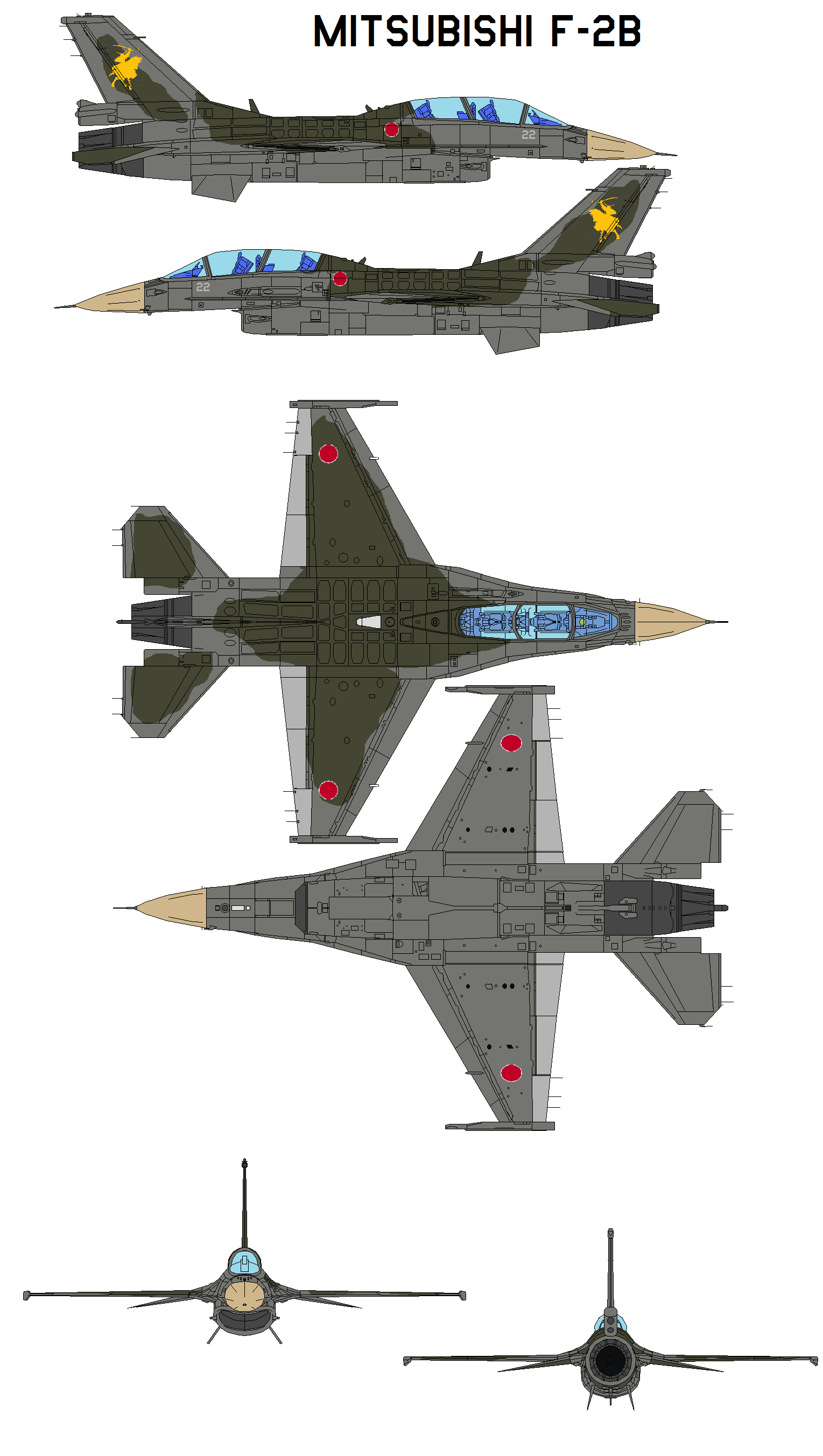ShopDreamUp AI ArtDreamUp
Deviation Actions
Suggested Deviants
Suggested Collections
You Might Like…
Featured in Groups
Description
Mitsubishi F-2 B
n October 1987, Japan selected the F-16C Fighting Falcon as the basis for a much developed version to replace the Mitsubishi F-1, primarily in the fighter support role. Although a costly ad controversial programme - one F-2 costs at least the same as four Block 52/52 F-16Cs - the F-2 illustrates Japan's commitment to maintaining its high-technology aerospace industry.
The F-2 features a new wing of 25 per cent greater-area and co-cured, all-composite construction, with radar absorbent material on the leading edges. In order to house additional mission avionics that include an integrated electronic warfare system, the F-2's fuselage has a lengthened forward section when compared to the F-16C. Other features include a longer nose to accommodate an active phased-array radar, a larger tailplane, a brake chute and a strengthened canopy.
Mitsubishi is the prime contractor responsible for airframe assembly as well as manufacture of the forward fuselage section, while the other major assemblies are produced by Lockheed Martin, Kawasaki and Fuji. With either wing tip-mounted AIM-9 or Mitsubishi AAM-3 air-to-air missiles, the F-2 still has 11 hardpoints available for other stores, including the ASM-2 anti-ship missile as one of the principal weapons. The F-2 programme has suffered long delays, cost escalation and a number of structural problems including wing cracking and severe flutter. Four prototypes have been built comprising two single-seat XF-2As and a pair of two-seat XF-2B.
The first XF-2A recorded the type's maiden flight on 7 October 1995. In late 1995 the Japanese government approved a programme for the manufacture of 130 aircraft with an entry into service scheduler for 1999. Delays resulting from modifications to cure structural problems delayed the F-2's entry into operational service until 2001. The current production programme calls for production of 83 F-2A single-seaters and 47 F-2B two-seaters. Retaining full combat capability, these have a fuel capacity reduced by 685 liters. The F-2Bs will be used for conversion and proficiency training, replacing Mitsubishi T-2s.
Entered service 2001
Crew 2 men
Dimensions and weight
Length 15.52 m
Wing span 11.13 m
Height 4.69 m
Weight (empty) 9.53 t
Weight (maximum take off) 22.1 t
Engines and performance
Engines 1 x General Electric F110-GE-129 turbofan
Traction (dry / with afterburning) 75.62 / 131.22 kN
Maximum speed 2 125 km/h
Combat radius > 843 km
Armament
Cannon 1 x 20-mm JM61A1 cannon
Missiles ASM-1/2 anti-ship missiles, AIM-7F / AIM-7M+ Sparrow, AIM-9L or AA-3+ air-to-air missiles
Bombs Mk 82 and JM117 free-fall bombs with infra-red seeker heads, CBU-87/B cluster bombs
Other JLAU-3/A and RL-4 rocket launcher
n October 1987, Japan selected the F-16C Fighting Falcon as the basis for a much developed version to replace the Mitsubishi F-1, primarily in the fighter support role. Although a costly ad controversial programme - one F-2 costs at least the same as four Block 52/52 F-16Cs - the F-2 illustrates Japan's commitment to maintaining its high-technology aerospace industry.
The F-2 features a new wing of 25 per cent greater-area and co-cured, all-composite construction, with radar absorbent material on the leading edges. In order to house additional mission avionics that include an integrated electronic warfare system, the F-2's fuselage has a lengthened forward section when compared to the F-16C. Other features include a longer nose to accommodate an active phased-array radar, a larger tailplane, a brake chute and a strengthened canopy.
Mitsubishi is the prime contractor responsible for airframe assembly as well as manufacture of the forward fuselage section, while the other major assemblies are produced by Lockheed Martin, Kawasaki and Fuji. With either wing tip-mounted AIM-9 or Mitsubishi AAM-3 air-to-air missiles, the F-2 still has 11 hardpoints available for other stores, including the ASM-2 anti-ship missile as one of the principal weapons. The F-2 programme has suffered long delays, cost escalation and a number of structural problems including wing cracking and severe flutter. Four prototypes have been built comprising two single-seat XF-2As and a pair of two-seat XF-2B.
The first XF-2A recorded the type's maiden flight on 7 October 1995. In late 1995 the Japanese government approved a programme for the manufacture of 130 aircraft with an entry into service scheduler for 1999. Delays resulting from modifications to cure structural problems delayed the F-2's entry into operational service until 2001. The current production programme calls for production of 83 F-2A single-seaters and 47 F-2B two-seaters. Retaining full combat capability, these have a fuel capacity reduced by 685 liters. The F-2Bs will be used for conversion and proficiency training, replacing Mitsubishi T-2s.
Entered service 2001
Crew 2 men
Dimensions and weight
Length 15.52 m
Wing span 11.13 m
Height 4.69 m
Weight (empty) 9.53 t
Weight (maximum take off) 22.1 t
Engines and performance
Engines 1 x General Electric F110-GE-129 turbofan
Traction (dry / with afterburning) 75.62 / 131.22 kN
Maximum speed 2 125 km/h
Combat radius > 843 km
Armament
Cannon 1 x 20-mm JM61A1 cannon
Missiles ASM-1/2 anti-ship missiles, AIM-7F / AIM-7M+ Sparrow, AIM-9L or AA-3+ air-to-air missiles
Bombs Mk 82 and JM117 free-fall bombs with infra-red seeker heads, CBU-87/B cluster bombs
Other JLAU-3/A and RL-4 rocket launcher
Image size
1529x2705px 175.95 KB
Comments4
Join the community to add your comment. Already a deviant? Log In
Could you do f Sixteen please

































